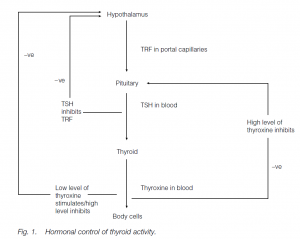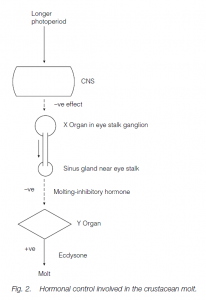Animal Hormones
Vertebrate Endocrine Glands and Hormones
Hormones and Nerves
Increasing size and complexity in multicellular animals necessitates communication systems for integration and control. Two principal methods are used:
- Chemical control, using chemical messengers or hormones within the endocrine system (or, more locally, between cells).
- Electrical control, using nerves. Generally, nerves are used for immediate, short-term responses and control, whereas hormones are used for long-term control associated with metabolism, growth, and reproduction. There is frequent co-operation and inter reliance between the two arms of the integration and control system.
Hormones and the endocrine system
Hormones can be defined as chemical messengers. They are produced by endocrine glands of epithelial origin and are released directly into body fluids such as hemolymph or blood. Hormones are synthesized intracellularly where they may be stored in vesicles and are released by exocytosis.
Hormones may be:
- water-soluble peptides or proteins (e.g. insulin);
- water-insoluble steroids (e.g. estrogen);
- amino acid derivatives such as catecholamines [e.g. adrenaline (epinephrine)].
Protein, peptide, and catecholamine hormones are transported around the body in solution. They bind to receptors on the cell membrane; the hormone-receptor complex activates the production and release of intracellular second messengers. (The extracellular protein hormone is the first messenger.) An example of a second messenger is cAMP. Here the protein hormone binds to a receptor and the complex activates adenyl cyclase which facilitates the conversion of ATP to cAMP. cAMP, the second messenger, in turn, promotes the activation of protein kinases within the cell which then activate phosphorylases.
Steroid hormones diffuse across the cell membrane where they bind to a cytoplasmic receptor. The hormone-receptor complex is received by an acceptor on the chromosome, resulting in increased transcription of DNA.
Concentrations of hormones in body fluids are low (10–11–10–12 M) and are normally under the control of negative feedback processes. Positive feedback may be utilized; for example high levels of estrogen from the ovary stimulate an increased release of luteotrophic hormone from the anterior pituitary, leading to ovulation, in the menstrual cycle in women.
Hierarchy of Control
There is often a hierarchy of endocrine control. Blood levels of thyroxine are under the control of the anterior pituitary through the mediation of thyroidstimulating hormone (TSH); the anterior pituitary is, in turn, under the control of tropic hormones secreted by neurosecretory cells in the hypothalamus, here secreting thyrotropin-releasing factor (TRF), which stimulates synthesis/release of TSH. High levels of thyroxine inhibit TRF production through a long negative feedback loop and inhibit TSH through a short negative feedback loop An example of nervous–endocrine co-operation is seen in milk release in a suckling baby: suckling results in nervous impulses being sent to the brain, which results in increased release of oxytocin by the hypothalamus/posterior pituitary system; oxytocin facilitates milk ejection.

Invertebrate hormones: crustacean molt
Neurosecretory cells and hormones are found in most metazoan phyla, from Cnidaria to Chordata, the hormones usually affecting reproduction and growth. Molting during crustacean growth is an example of an invertebrate hormonally controlled system. The epithelial-derived Y organ at the eyestalk base produces ecdysone which promotes molting. It is regulated by neurosecretory cells in the X organ of the eyestalk: hormones from the X gland are transported along the axons and are stored in their swollen ends within the sinus gland, also within the eyestalk, and from the sinus gland they are released into the hemolymph. The X gland/sinus gland hormone inhibits molting by preventing the release of ecdysone from the Y gland. Increasing day length in the spring results in a nervous inhibition of X gland/sinus gland activity, permitting the release of ecdysone and a subsequent molt. (A similar system promotes metamorphosis in holometabolous insects.

Vertebrate Hormones
Neurosecretion is pivotal in the vertebrate endocrine system because hypothalamic cells affect pituitary gland activity.
Pituitary development
The infundibulum develops into the neurohypophysis (posterior pituitary) which connects with that part of the brain (ventral diencephalon) which becomes the hypothalamus. Rathke’s pouch develops into the adenohypophysis (anterior pituitary); a portal system of capillaries and venules that links the hypothalamus and the anterior pituitary.
Vertebrate posterior pituitary
Posterior pituitary hormones are neurosecretions from hypothalamic cells ending in the posterior pituitary. ADH (vasopressin) promotes water resorption from the kidney, water uptake across amphibian skin, and contraction of arteriolar muscles. Oxytocin promotes smooth muscle contraction (e.g. in milk ejection or in the uterus during labor).
Vertebrate anterior pituitary
Anterior pituitary peptide or protein hormones made by discrete cell types include:
- prolactin (PRL), controlling production and secretion of mammalian milk, avian nest-building, and the maintenance of the larval state in amphibians;
- melanophore-stimulating hormone (MSH) causes the skins of poikilothermic vertebrates to darken by dispersing melanin-containing granules through melanophore cells. Other hormones affect the production and release of hormones by other endocrine glands, giving the anterior pituitary the name ‘master gland’:
- growth hormone (GH) promotes body growth;
- gonadotropins [follicle-stimulating hormone (FSH) and luteinizing hormone (LH)] promote sex steroid synthesis and release by the gonads;
- thyroid-stimulating hormone (TSH) stimulates the production of thyroid hormones;
- adrenocorticotropic hormone (ACTH) stimulates corticosteroid release from the adrenal cortex.
Many anterior pituitary hormones are themselves under the control of releasing hormones from the hypothalamus: hormones such as gonadotropin-releasing factor (or hormone) are synthesized by neurosecretory hypothalamic neurons and reach the pituitary via the pituitary portal capillaries. Nervous input and environmental cues such as day length also influence endocrine secretion. GH and PRL secretion are suppressed by hypothalamic inhibiting hormones.
Vertebrate hormonal systems
Among the systems invertebrates are:
- GH is produced by the anterior pituitary; this works with somatomedin from the liver and thyroid hormones to promote and control growth. GH promotes the proliferation of cartilage in epiphyseal plates of bones and the growth of connective tissues. It also promotes somatomedin synthesis which encourages cell division and differentiation. Low GH levels induce hypothalamic GH-releasing factor; high levels induce GH-inhibiting factor (somatostatin). Excess GH leads to acromegaly (excessive bone development leading to facial deformities and gigantism). Deficient GH leads to pituitary dwarfism.
- Thyroid hormones including thyroxine and tri-iodothyronine, are synthesized/ secreted under the influence of anterior pituitary TSH. Thyroid hormones activate genes, promoting, particularly, respiratory enzyme synthesis. In amphibians, thyroid hormones promote metamorphosis.
- Melatonin and the pineal gland: melatonin is secreted in darkness (the pineal has a neural link to the eye) and influences color changes, breeding cycles, etc. Melatonin inhibits ovary and testis development in rodents. (In many poikilotherms, e.g. Sphenodon punctatum, the tuatara, a primitive lizard-like reptile, the pineal develops into a photoreceptive organ, a ‘third eye’.)
- Erythropoietin from the kidney promotes erythropoiesis.
- A number of thymic factors (e.g. thymosin) are involved in T-lymphocyte development. Other hormone-like substances which promote growth are known, including cytokines such as interleukins involved in the control of immune responses, a nerve growth factor involved in neuron growth, and putative thrombopoietin involved in platelet production.
- Gastrin, secretin, and CCK–PZ, secreted by the alimentary tract, are involved in the control of digestive processes.
- Insulin and glucagon, from the pancreas, are involved in the homeostatic control of blood glucose levels.
- Adrenaline (epinephrine), formed by methylating noradrenaline (norepinephrine) through the mediation of glucocorticoids, produced by the chromaffin cells of the adrenal medulla; it reinforces the effects of the sympathetic nervous system in stress and fright/fight/flight responses.
- Glucocorticoids (e.g. cortisol) secreted by the adrenal cortex; are involved in protein and carbohydrate metabolism and, with adrenaline (epinephrine) are associated with stress control. They suppress many inflammatory and immune responses. Also produced in the adrenal cortex are cortical androgens (important in women for some muscle and body hair development – in men testosterone from the testes is more important) and aldosterone, important for electrolyte balance and blood pressure control.
- Parathyroid hormone secreted by the parathyroid glands in response to lowered blood calcium levels: it facilitates calcium uptake from bone and its retention by the kidneys. Vitamin D (cholecalciferol) is made in the skin when it is exposed to sunlight: it increases calcium and phosphate uptake from the gut.
- Reproductive hormones including gonadotropins from the anterior pituitary which stimulate the production of sex steroids from the gonads. These are involved in gametogenesis, ovulation, and reproductive cycles, such as the menstrual cycle in women, human puberty and menopause, and the development of secondary sexual characteristics.
